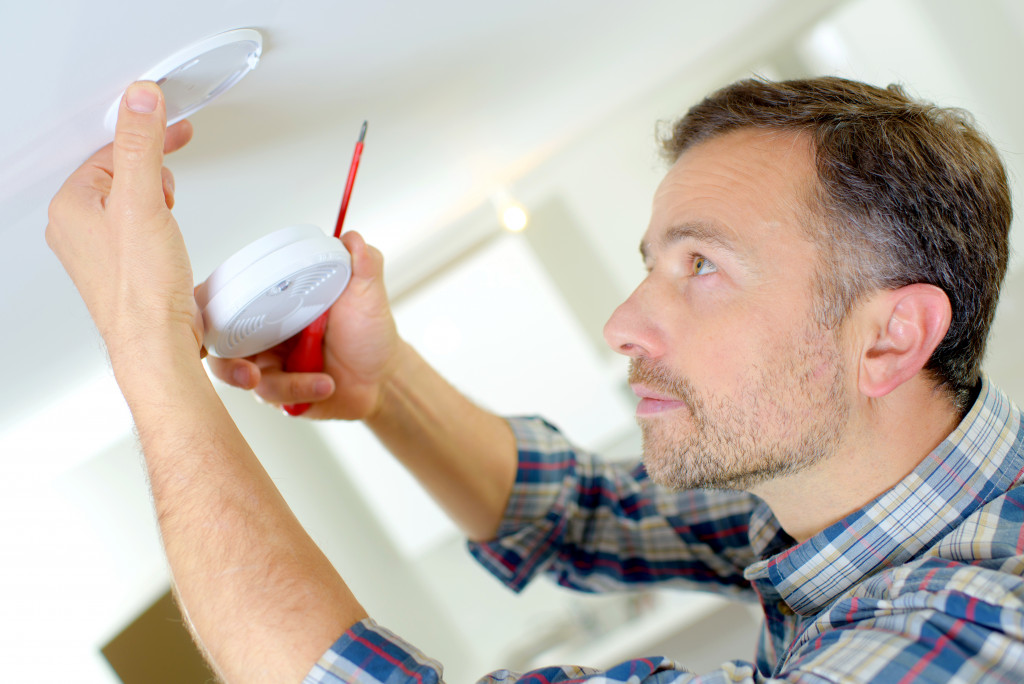• Inspect fireplaces and chimneys for any blockages or creosote build-up before using them.
• Have an EICR (electrical installation condition report) done to ensure electrical wiring is up to code and safe.
• Check appliances, heating systems, stoves & ovens, refrigerators, and dishwashers for any signs of deterioration.
• Install smoke and carbon monoxide detectors throughout the home, testing them regularly according to manufacturer instructions.
• Check all windows and doors for drafts and replace weatherstripping materials if necessary.
Moving into your new home is an exciting time, but it can also be a bit overwhelming. Before you start unpacking and arranging furniture, you should complete some critical safety tasks first. Doing them now can help keep your family safe and make life in your new home much more enjoyable. Look at some of the essential tasks to do before moving into your new home.
1. Clean & Inspect Fireplaces & Chimneys
If your new home has a fireplace or chimney, you must inspect them for dirt, soot, creosote build-up, and any other blockages before using them for the first time. Creosote is a highly combustible substance that can lead to dangerous chimney fires if left unchecked. It’s also essential to have any fireplaces inspected by a professional who can ensure that they’re in good working order and up to code. This will help keep your family safe and increase the efficiency of burning wood or pellets in the fireplace.
2. Get Electrical Wirings Inspected
About 50,000 house fires occur each year due to electrical malfunctions, so it’s critical to get an EICR (electrical installation condition report) done at your new home to ensure that your electrical wiring is up to code and safe. A professional EICR assessor can identify any issues with the wiring and suggest necessary repairs. They can also ensure that all outlets are properly grounded and safe.
3. Check Your Appliances
Before you start using your appliances, you must ensure they are working correctly. Different appliances come with different safety instructions, so read the manuals and ensure you understand how to use them safely. Additionally, have an electrician or plumber inspect any gas or wet appliances to ensure they’re installed correctly and won’t cause any hazardous leaks. Focus on the following crucial home appliances:
a. Heating systems
Heating systems can be dangerous if they are not set up correctly. Many older heating systems may even be combustible if they aren’t properly maintained.
b. Stoves and ovens
Ensure the connections between your stoves or ovens and the gas line are secure. Have a professional check that everything is connected correctly and that there are no gas or carbon monoxide leaks.

c. Refrigerators
Check the seals and gaskets to make sure they’re in good condition. If they look worn or damaged, replace them immediately to prevent air leakage and energy waste.
d. Dishwashers
Like your other appliances, check the dishwasher hoses for any signs of deterioration or kinks that could potentially cause water leaks. Leaks can lead to water damage and mold growth, so it’s important to ensure they are securely connected.
4. Inspect Smoke Detectors & Carbon Monoxide Detectors
Smoke and carbon monoxide detectors are essential for keeping your family safe in case of fire or gas leaks, but they must be correctly installed and maintained regularly. Take the time to ensure all smoke and carbon monoxide detectors are correctly installed throughout your home, and test them regularly according to manufacturer instructions.
You should also check their expiration dates and immediately replace any expired units with new ones. Batteries should be checked every month and replaced at least once a year. Don’t forget to get radon detectors if you live in an area where radon gas is an issue.

5. Check Windows & Doors for Drafts
Drafty windows and doors can let cold air into your home during winter, which will drive up energy costs and decrease comfort levels inside the house. Inspect each window and door for drafts by holding a lit candle near them while feeling for cold air coming through any gaps around the frames or seals. If you find any drafty areas, consider investing in weatherstripping materials from a local hardware store to help keep warm air inside during winter. This will also help prevent pesky insects from entering your home.
Moving into a new place is an exciting experience, but it’s essential not to overlook specific safety tasks that must be completed before settling in completely. Taking care of these tasks upfront will provide peace of mind knowing that your family is safe when living in their new home! From inspecting fireplaces and chimneys to checking appliances and windows, these tasks can help make your home safe and comfortable.

